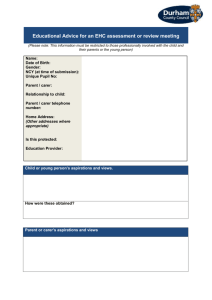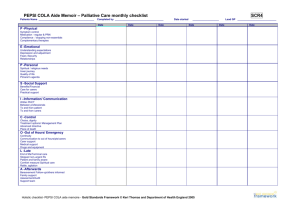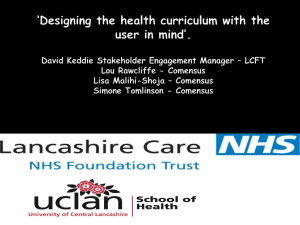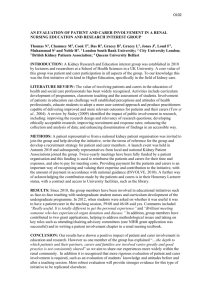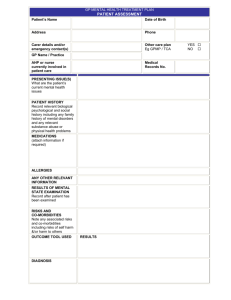4.2 Powerpoint presentation
advertisement
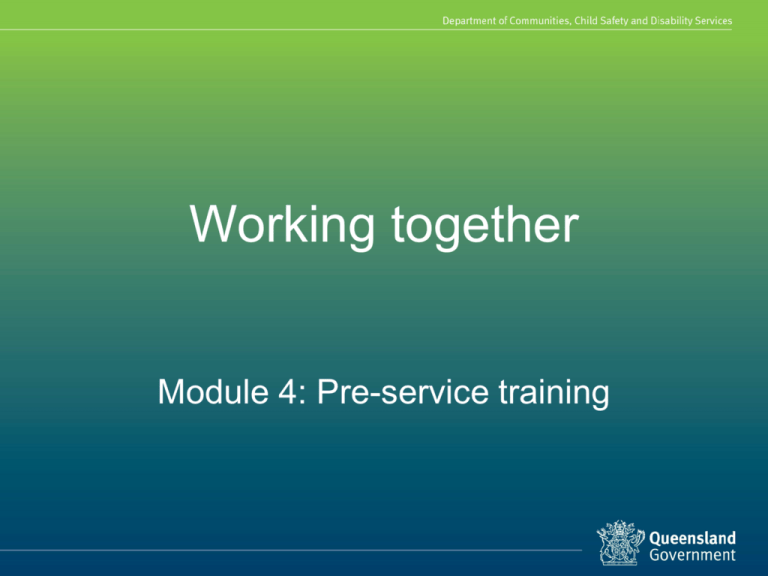
Working together Module 4: Pre-service training Re-cap of module one: Context of foster care Learning Outcomes At the end of this module participants will be able to: • Explain why children can require out-of-home care placements • Demonstrate knowledge of how children come into care and who is involved in decision making • Discuss an overview of the needs of children in care, and the roles and responsibilities of foster carers in meeting those needs. Content 1. Why do you want to be a foster carer? What will be the impact on your own family and friends? 2. Why does a child or young person need an out-of-home care placement? 3. How do children and young people come into care and who makes decisions? 4. Roles and responsibilities of foster carers in meeting the needs of children and young people and the differing roles between the Department of Communities, Child Safety and Disability Services, and Care Services. 2 Re cap Module three: Early Days in a Placement Learning Outcomes At the end of this module participants will be able to: 1. Demonstrate understanding of the framework for decision making in meeting a child or young person’s protective needs. 2. Discuss the factors that would be taken into consideration in deciding whether to accept a placement. 3. Outline key factors in building a relationship with a child or young person. 4. Demonstrate knowledge of ways to encourage a child or young person’s sense of self and identity. 5. Demonstrate understanding of advocacy for children and young people. Content 1. Accepting a Placement – what do I need to know and consider? 2. Building Relationships – how to welcome a child or young person. 3. Decision Making about how to meet a child or young persons needs. 4. Promoting a positive sense of self and identity for a child or young person. 5. Advocacy for children and young people. 3 Module four: Working Together Learning Outcomes At the end of this module participants will be able to: 1. Demonstrate how all key players can work together – including what to do when things go wrong. 2. Demonstrate an understanding of carer support options. 3. Demonstrate an understanding of transition to independence. 4. Demonstrate an understanding of the complexities of ending a placement. 4 Module four: Working Together Content 1. Working in partnership 2. When things go wrong 3. Carer supports – support and financial assistance 4. Guest panel 5. Transition to independence 6. Saying goodbye 7. Evaluation 5 Working in partnership All parties, through the Statement of Commitment, have made a commitment to: • ensure and promote the safety, wellbeing and best interest of the child • develop effective and respectful partnerships • comprehend each others roles and responsibilities • understand the rights of carers including: – the right to feel safe – the right to feel supported • recognise the responsibilities of carers, which include a responsibility: – to meet the Statement of Standards – to participate in the development of a Foster Care Agreement – to undertake training and advocate for the child – submit an application and related documents for renewal 6 Working in partnership Brainstorm Who might you be working in partnership with to enhance the child’s placement? 7 Statement of Commitment Child Safety Services roles and responsibilities • Coordinate a whole of government approach to child protection • Provide policies and procedures that establish and monitor quality standards of care and support carers • Provide assistance to meet the legal standards of care - Statement of Standards, Principles of the Act and Charter of Rights • Provide initial and ongoing training to carers Foster Carers roles and responsibilities • Meet the legal standards of care, as above • Participate in the development of a Foster Care Agreement • Undertake training and advocate for a child • Tell Child Safety when there is a change in circumstance 8 When concerns are raised about the quality of care provided by a carer Discussion question What do you think should happen if there are allegations that a child in care has been harmed by their carer? 9 Standards of care issues There are 3 different response options to standards of care issues. The response is based on whether the information received indicates: • • • that the concerns don’t warrant a standard of care review that the standards of care may not have been met for a child that the child has experienced harm or it is suspected that they have experienced harm. Child Safety is responsible for working collaboratively with the child’s care team to ensure that the child is safe from harm, and that appropriate actions are taken to resolve the identified concerns. 10 Responses if issues are raised about the standards of care 1. Continue to monitor the standards of care – concerns that do not warrant a Standard of care review 2. A Standard of care review – information indicates that the child’s care has not met the legislated standards of care 3. A Harm report – information suggests the child has been harmed in care. 11 1. Continue monitoring the standards of care The care team will continue to monitor the child’s care and support the carer in their role, to prevent escalation of issues. Concerns raised may still need to be addressed e.g. carer may be provided with additional training, information or support. 12 2. Standard of care review • To determine whether the child’s care has been meeting the required standards; what contributed to this and how the care team can address any concerns. • A Child Safety or foster and kinship care services worker will meet with the carer to discuss the concerns. The department will have a talk to the child to gather their views. • Carer may have a support person and advocate. • Outcome: Standards met OR Standards not met. • If outcome is Standards not met: Review placement agreement and consider review of Foster Carer Agreement. 3. Harm report • Investigation and assessment conducted by Child Safety to determine if the child has been harmed; who is responsible and any future risk of harm. • Child may be removed if concerns are very serious and child is at immediate risk of harm. • Carer/s are interviewed. Child is interviewed. • Carer may have a support person and advocate present. 3. Harm report (cont.) Outcomes 1. Substantiated harm – standards not met 2. Substantiated harm – standards met 3. Unsubstantiated – standards not met 4. Unsubstantiated harm – standards met 5. No outcome (in exceptional circumstances only) An action plan will be developed if the child has been harmed and/or the carer has not met the standards of care. Carer Supports Exercise Draw up a table and list the challenges you may face in the role. Add some strategies for managing these. Challenges Support 17 Carer Supports • Foster Care Queensland (FCQ) – 07 3256 6166 • FAST delegate – 07 3256 6166 • Foster and Kinship Care organisation • Foster and Kinship Carer Support Line – 1300 729 309 • Child Safety After Hours Service Centre – 07 3235 9901 (carers only) • Queensland Aboriginal and Torres Strait Islander Child Protection Peak (QATSICPP) – 07 328 8500 • PeakCare Queensland – 07 3368 1050 • Queensland Health – 13 Health (13 43 25 84) • CREATE foundation – 1800 655 105 or 3317 6020 • Office of the Public Guardian – 1800 661 533 • Child Safety staff (contact details will be applicable to your Child Safety Officer and the Child Safety Service Centre you are affiliated with). 18 Carer Supports – FAST FAST – Foster Advocacy and Support Team FAST is a primary service delivery area for FCQ FAST is funded by the Department of Communities, Child Safety and Disability Services FAST delegates are active carers with at least two years caring experience who have been professionally trained and supervised through FCQ staff to provide support, advocacy and advise to other carers There is a FAST delegate attached to most Service Centres who have local knowledge and partnerships which benefit their support of other carers For those areas where there is no FAST delegate – simply call FCQ’s office directly, there are 4 case officers ready to take your call 3256 6166 19 Carer Supports Financial Support Emotional support Practical Support Fortnightly caring allowance Carer telephone support line FAST delegate Regional and remote loading Foster and Kinship Care worker Child Safety Officer FAST delegate Awareness of other financial support where required i.e. Child Respite Related Costs Friends and support networks High Support Needs Allowance Child Safety Officer Complex Support Needs Allowance Child Safety After Hours Service Centre Social support Access to support groups and networks Task focused problem solving support Friends/family Specialist advice and assistance – psychiatric, medical or education services Access to groups – FCQ, Peakcare FAST delegates Foster and kinship groups Facilitating referrals for children to specialist services Foster and kinship care worker Carer Handbook Carer Information Sheets Carers Business Discount Card Professional development Learning – carer information sheets, books, DVDs, journal articles Training – standard, advanced, targeted training for different skill level or learning needs Reflection on role/skills 20 Foster Carer Agreement A written agreement negotiated with a foster carer during the initial approval assessment; at renewal of approval; and where a foster carer or Child Safety staff initiates a review. Placement considerations • gender and age range • your language/culture • school catchment area • immunisation – views and adherence • placement types you are not able or wish to consider Placement capacity • the number of children you are able to care for (including practical limitations) A development and support plan • the area/s of learning and development identified and how these will be met • costs associated with the development and support plan Support plan and network • Identification of other elements of support 21 Changes in circumstances As part of the team you need to tell Child Safety if you, or household members, have any changes in circumstances: • Household membership – a new person joins or someone leaves • • • • • • • Traffic history, criminal history Domestic and family violence Involvement by any child protection agency in Australia Personal circumstances – health issues, employment demands Spousal arrangements – divorce, separation, death Change of address Intention to provide care to other children – relatives, family day care Complete a Change in Circumstances form and provide it to your Child Safety Service Centre. A review of your foster care agreement may occur, depending on the change. 22 Guest Panel or DVD 23 Transition to independence • All young people subject to a CPO granting custody or guardianship to the Chief Executive have the right to receive assistance and support with their transition to independence (T2I), to maximise their life opportunities and choices. • Transition to independence planning commences in the calendar year that a young person turns 15. • Transition to independence planning is the opportunity for young people to identify their future goals and needs, and to work towards these with the support of the department and the community. 24 Transition to independence Transition to independence planning is an ongoing process that should be gradual, supportive and flexible. Most young people in care leave home earlier than their peers would. Young people transitioning to independence can face the following challenges: • Reconnecting with family • Understanding why they came into care • Limited social connections/community support. Transition to independence - Supports Child Safety will work with the young person to meet their identified T2I goals, which may include: • getting financial assistance for further studies, apprenticeship/traineeship etc. • obtaining a driver’s licence • developing life skills – e.g. cooking or budgeting • moving into semi-supported accommodation • assisting in applying for TILA (Transition to Independent Living) payments of up to $1,500. Next Step After Care Services are funded to help young people up to 21 years old who have transitioned from care or other out-of-home care arrangements, and to get the help they need to live independently: • provides a connection program 24 hours a day, 7 days a week (phone and text) • provides tailored individual support ranging from advice, information provision, to more involved support such as assistance with securing accommodation etc. 26 Transition to independence What carers can do • Referrals – assist the young people to access services that can help them in the short term and long term. • Assist with T2I planning – with assistance from the Child Safety Officer help the young person plan their independence. • Individual Advocacy – advocate on behalf of the young person to ensure they receive the supports they need. • Support – provide emotional and practical support the young person will need for their journey to independence and beyond 27 Transition to independence - Resources There are a range of resources to assist the young person and their care team plan for transition to independence: • • • • • • • Go Your Own Way Information Kit CREATE your own future website TILA Fact Sheet Out of Care into Further Education, Training and Work Transitioning from care video resources After care services fact sheet. Sortli app - a free app to help young people think about and plan for T2I. Saying Goodbye Exercise Think about the ways in which you have said goodbye to someone before, what helped? What other strategies can be used to say goodbye? How might the move or transition to independence affect the child and your family? What support might the child, young person and your family need to cope with the move? At the end of any placement complete a Conclusion from Placement form. 29 Module four: Working Together Learning Outcomes At the end of this module participants will be able to: 1. Demonstrate how all key players can work together – including what to do when things go wrong. 2. Demonstrate understanding of carer support options 3. Demonstrate an understanding of transition to independence 4. Understand the complexities of ending a placement. 30 Pre Service Training Thank You
